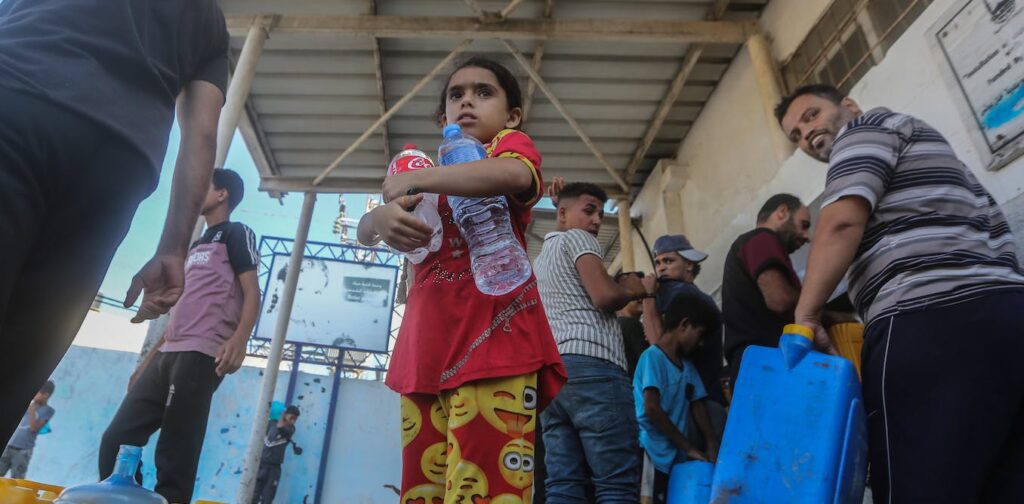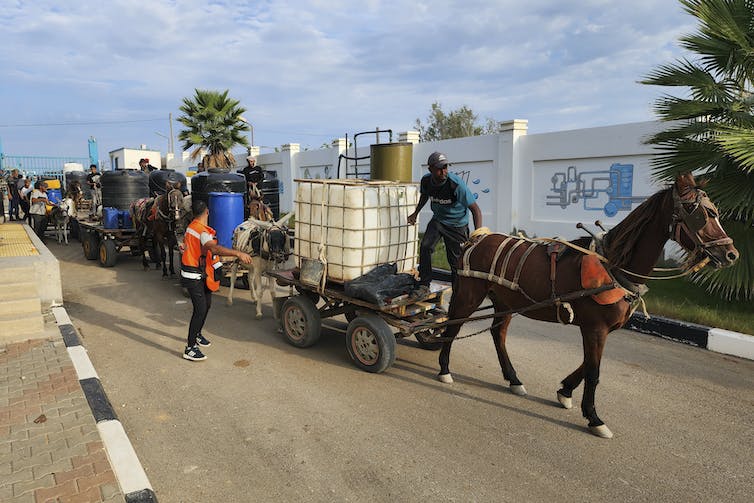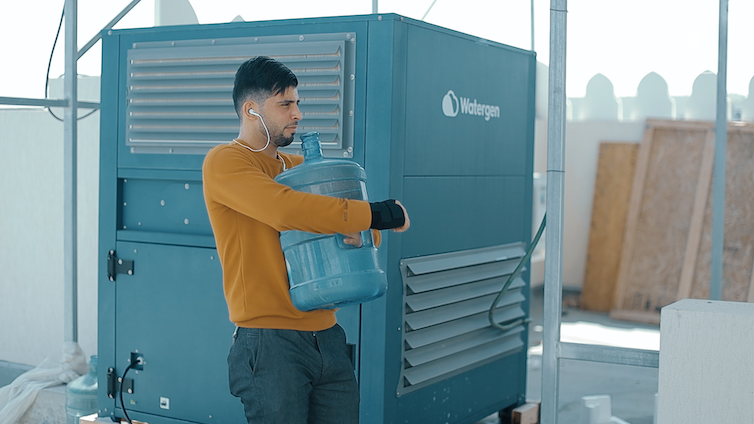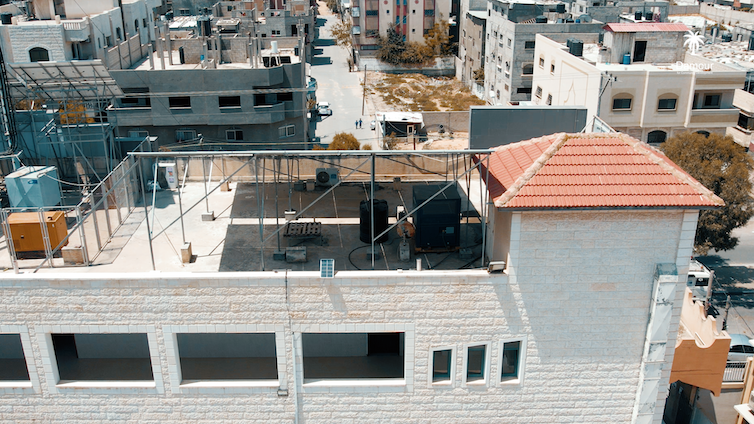Collaborative water management can be a building block for peace between Israelis and Palestinians

Water is a central element of the war between Israel and Hamas in the Gaza Strip. Israel controls several water pipelines entering Gaza, much as it controls most of life there. But water can also be a source of hope for an alternative future.
The Middle East is an arid region that is highly vulnerable to the effects of climate change. There is an essential need for solutions that offer equitable access to water and sanitation, and that protect Israel and the Palestinian territories’ shared water resources.
We study approaches to managing water and other environmental resources and conduct work at the Arava Institute for Environmental Studies, a
nonprofit teaching and research center in the south of Israel. At the institute, students and academics from Israel, the Palestinian territories and Jordan come together to learn from each other and work together, developing technologies and programs that meet the region’s water needs.
Our experience has shown us that working together creates understanding and friendships that defy the ongoing conflict.
We are not naïve. We recognize that water is central to the struggle between Israelis and Palestinians. Yet, as we see it, continuing to weaponize water will not make peace more likely. What it will do is amplify the suffering that is already taking place.
The Middle East is facing a water crisis, and divisions between Israelis and Palestinians have only exacerbated the problem. Experts argue that regional cooperation is the only practical strategy.
A dry region with a growing population
The combined population of Israelis and Palestinians living in Israel, Gaza and the West Bank is roughly 14 million. Both populations are growing at nearly 2% annually, compared with 0.4% per year for high-income countries. As the populations grow, so does demand for water.
The average yearly per capita water supply for the region is less than 500 cubic meters per capita. According to the United Nations and other experts, this amount is at the upper threshold of absolute water scarcity – the level at which nations can’t meet all demand, especially the large amounts needed for agriculture, and have to restrict water use.
For comparison, in 2015 the U.S. used 1,207 cubic meters of water per capita. One cubic meter is equal to 264 gallons.
Israel and the Palestinian territories’ main fresh water resources are the Jordan River system and two groundwater aquifers – one along the Mediterranean coast and the other beneath the central Judean mountain range. Palestinians in the West Bank have access mainly to the mountain aquifer system, and those in Gaza to the coastal aquifer. Israel uses both.
The 1993 Oslo peace accords included provisions allocating water between Israelis and Palestinians, but ongoing conflict and continued disagreements have hindered updating these agreements to reflect rising water demand.
Unequal access to water
From the foundation of the state of Israel, access to water resources has been as central to the nation’s conflict with the Palestinian people as competing claims to land. Israel has partially decoupled itself from water scarcity by building desalination plants along the Mediterranean coast.
In the West Bank, Israel’s continued occupation has impeded Palestinians’ ability to develop their own water network that could distribute water across the population. The situation in Gaza is even more dire.
Gaza has only a handful of desalination and wastewater treatment plants. Due to the ongoing war with Israel, all of these main plants now lack fuel and many are inoperable.
United Nations
Even before the Israel-Hamas war, Gaza had a massive water deficit. Its main source is groundwater, which has been significantly overpumped, and now is so salty as to be undrinkable due to seawater intrusion into the aquifer.
Before the war, most Gazans relied on private water vendors and a few small desalination plants for drinking water. Israel also piped about 10 million cubic meters of water each year into Gaza. But all told, the water supply is not large enough to meet the entire population’s needs. Now, because of the war, no fuel is entering Gaza to run the desalination plants, leaving them inoperable.
Weaponizing water
Israel has turned off water and fuel shipments to Gaza in order to punish Hamas. We believe this strategy has turned a disaster into a catastrophe that is only likely to get worse.
We do not expect that lack of access to drinking water and sanitation will cause Hamas to lay down its arms. But it already is bringing additional misery to the civilians of Gaza and giving them further reason to hate Israel, and will add to international condemnation of Israel.
U.N. officials are warning that lack of water and sanitation will precipitate an enormous health crisis that will particularly affect women and children. It could lead to outbreaks of waterborne disease that will spread rapidly across Gaza’s crowded and besieged population. Gazan hospitals are already overwhelmed with casualties, and lack water and electricity.

A drinking water treatment station in Deir al Balah, central Gaza, Oct. 27, 2023.
AP Photo/Hassan Eslaiah
Collaborative water projects
From 2019 until 2023, the Arava Institute worked together with a Palestinian nonprofit group, which we are not naming here out of concern for its members’ safety; an Israeli water tech company called Watergen; and the Friends of the Arava Institute, a U.S.-based nonprofit, to install seven atmospheric water generators to Gaza. These devices, which pull humidity from the atmosphere and turn it into high-quality drinking water, run on solar power to ensure around-the-clock operation in the energy-poor Gaza Strip.

A water generator installed by the Arava Institute in Gaza.
Arava Institute, CC BY-ND
We installed the first generator in a small municipality in central Gaza, along the border with Israel, in 2019. The second, larger generator was installed in a major hospital in central Gaza in 2020. During May 2021 hostilities between Hamas and Israel, when water supplies were cut off to many communities, these generators were the only sources of drinking water for many people in the surrounding communities.
In 2023, we raised funds to install five more water generators at medical facilities throughout Gaza. According to David Lehrer, director of the Arava Institute’s Track II Environmental Forum, two generators in south Gaza are still working and are the only sources of clean drinking water in the region. The fate of the other units is unclear.
Treating wastewater
In a separate project in 2020, we and our Palestinian partners installed a pilot mobile wastewater treatment plant in a Gazan village. The plant treats about 26,500 gallons (100 cubic meters) of wastewater per day, serving around 1,000 residents, and produces treated wastewater that is of sufficiently high quality to be used in agriculture. We estimate that about 25 of these mobile treatment plants could cover all of the village’s needs.

An atmospheric water generator on a building in Gaza.
Arava Institute, CC BY-ND
Many rural villages in Gaza have no centralized wastewater treatment system. Wastewater is collected in unsanitary cesspits in the middle of the road between houses. Raw sewage runs in open ditches from homes to the cesspits, which residents pump out around once a month.
Sewage then would normally be transported to a wastewater facility to be treated. But now, because of the war, without fuel for electricity, wastewater plants in Gaza are not working. Raw sewage is being dumped into ecologically important coastal wetlands, called wadis, and into the Mediterranean Sea.
This environmental and public health catastrophe also affects Israel. The Israeli seawater desalination plant in Ashkelon is only a few kilometers north of Gaza and cannot operate if it risks pulling in polluted seawater. Over the years, lack of adequate sewage treatment in Gaza has caused the plant to periodically halt operations.
Working closely with Israeli and Palestinian partners is not easy. People from all sides have histories of trauma and grief, and in most cases, very little experience of the other. But working together on shared water challenges can bring people together.
We know that an alternative future is possible – a future that is grounded in a sense of shared humanity and respect. Indeed, we believe it is the only future that is possible for the intertwined reality of Israelis and Palestinians.






